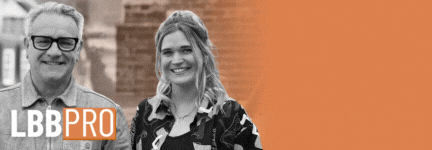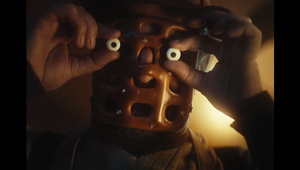
The Directors: Nathalie Lamb

With a diverse body of work spanning various genres and techniques, Nathalie Lamb has become a master of crafting compelling narratives through advertisements, feature films and stop-motion animations. Her passion for filmmaking emerged early on during her upbringing in sunny southern Germany. Later, at the renowned Filmakademie Baden-Wuerttemberg, Nathalie honed her skills by studying the art of direction.
Since then, Nathalie has amassed an impressive filmography showcasing her skills. Her animated short film, “Him & Her,” garnered international recognition at prominent festivals such as the Cannes Film Festival and the LA Shorts Fest in 2018. The following year, she debuted her 90-minute documentary, Silence is a Beautiful Sound, exploring the lives of six people on the threshold between the world of hearing and sign language.
Nathalie’s commercial collaborations include renowned brands such as Mercedes-Benz, PeTA, Hansaplast, and Fritz-Kola. In recognition of her talent, she was named the second runner-up for the SHOTS New Director of the Year award in 2022.
LBB> What elements of a script sets one apart from the other and what sort of scripts get you excited to shoot them?
Nathalie> I am always interested in a creative approach and enjoy crafting unique worlds, playing with colours and cinematic styles, and bringing lovable characters to life. I am exceptionally passionate about scripts that hold value. This can be due to their underlying message, storytelling, or even a detail like a place, prop, or feeling I can relate to.
LBB> How do you approach creating a treatment for a spot?
Nathalie> While reading a script, I have a million ideas that come to my mind, which I have to write down first. Then I ask myself: What's the main idea? What's the essence? And how can I make this piece unique?
I describe how I envision the story in every detail—each frame, set, transition, and character—so when you read it, you see the film.
My treatments are usually very personal; whether it's a comedy or an emotional story, I bring my own experiences and observations of my family, friends, and roommates to the spot. This is what breathes life into my protagonists, making them feel relatable, even in the most magical world.
LBB> If the script is for a brand that you're not familiar with/ don’t have a big affinity with or a market you're new to, how important is it for you to do research and understand that strategic and contextual side of the ad? If it’s important to you, how do you do it?
Nathalie> When it comes to research, I'm very accurate. The more I know, the better decisions I can make.
When I am not familiar with a part, I find someone who is familiar with it and call them. Interviewing people who are experts in a particular field is fun and teaches me about nuances and details I wouldn't find on the internet in such a short time. It's most enjoyable to draw ideas from real life.
LBB> For you, what is the most important working relationship for a director to have with another person in making an ad? And why?
Nathalie> I value each working relationship and believe that the magic is created through collaboration with the crew. I have a special love for the art department; I enjoy colour palettes, inventions, and places with a keen eye for detail.
The producer is the person I spend the most time with, and they are involved in all significant decisions from the first call to the final delivery. Therefore, I prefer working with producers who understand the creative vision and have my back.
As a visual person, I work closely with the director of photography, who significantly impacts the film's look. I esteem cinematographers who capture beautiful images while prioritising supporting the story.
LBB> What type of work are you most passionate about - is there a particular genre or subject matter or style you are most drawn to?
Nathalie> I'm passionate about a good story, no matter the genre, subject, or length. I've worked in classical storytelling commercials, stop-motion animation, VFX, drama, comedy, narrative short films, and feature-length documentaries. For me, it's always about the story.
I am particularly interested in things, changing rooms, and objects—bringing them to life by giving them personality. I am fascinated by the power of imagination, crafted worlds, and dreamlike places. But also characters I deeply care about, unseen perspectives, and meaningful ideas.
LBB> What misconception about you or your work do you most often encounter and why is it wrong?
Nathalie> I regularly get mistaken for a producer and am told I don't look like a director. What does a director look like?
I suppose this is because many of us still envision a man when we think of a director.
Some also assume that I am perfect for girly products. My work as a director is defined by my sensitive approach, empathy, and female perspective. I can direct every brand that relates to these strengths.
LBB> What’s the craziest problem you’ve come across in the course of a production – and how did you solve it?
Nathalie> Shooting a feature-length film with no budget.
“Silence is a Beautiful Sound” dives into the lives of six deaf protagonists. Growing up as the big sister of a deaf girl, I always had a different perspective on disabilities—more as a strength, a superpower, something you can be proud of. It's only society that disables.
The topic was so important to me that this film had to be made—against all odds.
So I worked with a small team on set (DP and me), using a Sony A7 and camping near the sets. I simultaneously produced, directed, shot B-camera, and sound-recorded (which is not easy when you communicate in sign language with the cast while holding a boom).
After years in the making, the response from the audience was overwhelming. Parents came to me, expressing that this film gave them hope, a new perspective, and the feeling that they were not alone. It was worth the effort.
LBB> How do you strike the balance between being open/collaborative with the agency and brand client while also protecting the idea?
Nathalie> The secret is to be a good listener, to understand what's important to the agency and client, and to build trust.
When the agency and client chose me to direct their ad, they had already seen my portfolio, talked to me on a chemistry call, and read my director's interpretation. From this moment on, my job is to protect the idea. As a film expert, I can explain which decisions have which effect on the audience and guide the client. If there is enough time on set, I simply shoot two versions. My intuition tells me what is worth fighting for.
LBB> What are your thoughts on opening up the production world to a more diverse pool of talent? Are you open to mentoring and apprenticeships on set?
Nathalie> Our productions are still biased, which means the films are also biased. With more diverse filmmakers, our films will improve and become more interesting. Everyone benefits from new perspectives, ideas, and untold stories.
I'm still at the beginning of my career, but I would be open to mentoring, especially if a talent faces barriers to accessing the film industry.
LBB> Your work is now presented in so many different formats - to what extent do you keep each in mind while you're working (and, equally, to what degree is it possible to do so)?
Nathalie> I prioritise and envision one hero version of the film.
Before shooting, I prepare a cheat sheet with all formats and packshot versions to keep an overview (for safety, I hand a copy of the sheet to a trusted assistant). On set, I work with frame lines and shoot in different tempos for each medium.
LBB> What’s your relationship with new technology and, if at all, how do you incorporate future-facing tech into your work (e.g. virtual production, interactive storytelling, AI/data-driven visuals etc)?
Nathalie> I'm a curious person and always interested in trying out new technology. I see technology like AI as a tool that can make life easier. It opens doors to a whole new universe of possibilities for telling stories that were inaccessible before. However, I have also learned in my filmmaking process that technology should only be used if it serves the idea.
LBB> Which 4 pieces of work do you feel really show off what you do best – and why?
Nathalie> "Heirloom" depicts a family's home over six decades. The sequence was shot in-camera using motion control, and we changed the set, cast, costume, and objects during the shoot. The DoP and I planned every single frame of the choreography in advance.
"Henry" tells the story of a boy packed in cotton wool. We created a surreal world with a specific style and colour palette and built the inventions from Henry's parents.
"One More Sense" was made intuitively and is a short version of my documentary about deaf children. It showcases their beautiful personalities and diversity.
"Him&Her" is a stop-motion short film that visualises a long-distance relationship through a treehouse. I animated it in eight weeks and had absolute creative freedom.













